Zoom
Trash

WoRMS - World Register of Marine Species. Aglantha digitale Author Fisheries and Oceans Canada, Moira Galbraith · JPG file - 100.25 kB - 889 x 600 pixels Extra informationCamera Maker: NikonCamera Model: E4500Image Title: Original Time Taken: 2003:06:16 19:36:11Time Digitized: 2003:06:16 19:36:11Shutter Speed: 10/11 secAperture: f/6.2ISO Sensitivity: 400Exposure Compensation: 0 EVMetering Mode: PatternFlash Fired: No FlashOriginal Width: 889 pixelsOriginal Height: 600 pixelsOrientation: 1: Normal (0 deg)Saturation Setting: 1Focal Length: 16 mmFocal Length Equivalent in 35mm Film: 77.
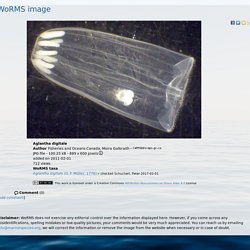
ITIS Standard Report Page: Aglantha digitale. Polyorchis penicillatus. Description: This hydromedusa has a bell that is at least as high as it is wide, with many (around 100) evenly-spaced, unbranched tentacles around the bell margin.
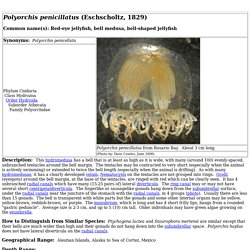
The tentacles may be contracted to very short (especially when the animal is actively swimming) or extended to twice the bell length (especially when the animal is drifting). As with many hydromedusae, it has a clearly developed velum. Nematocysts on the tentacles are not grouped into rings. Hydroskeleton ctenophora microscopy. Welcome to the Living World: Larvae of different animals. Larval stages - Dictionary of Invertebrate Zoology. Hanlon Lab – List of Publications. Click here to search PubMed for our latest publications Oshima, M., di Pauli von Treuheim, T., Carroll, J., Hanlon, R.

T., Walters, E. T., & Crook, R. J. (2016). Peripheral injury alters schooling behavior in squid, Doryteuthis pealeii. Buresch, K. Tyrie, E. Schnell, A. Kingston, A. Kingston, A. Chiao, C. Buresch, K. Allen, J. Week 08. Back to: Biology 112 SyllabusBack to: Biology 112: Evolution and EcologyHome PageBack to: Kenyon College Biology Department Week 8: Revolutions in biological diversity: animals and intelligence Assigned reading: Chapter 32 & 34 in text Quiz this week?
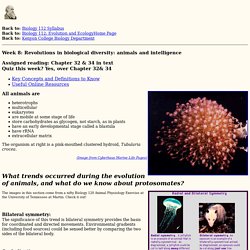
Yes, over Chapter 32& 34 All animals are heterotrophs multicellular eukaryotes are mobile at some stage of life store carbohydrates as glycogen, not starch, as in plants have an early developmental stage called a blastula have rRNA extracellular matrix. Fish. The Origin Of Vertebrates And The Rise Of Fishes The Vertebrates The Vertebrates are distinguished from other animals primarily by the presence of bone: 1.
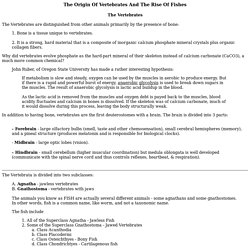
Bone is a tissue unique to vertebrates. 2. It is a strong, hard material that is a composite of inorganic calcium phosphate mineral crystals plus organic collagen fibers. Why did vertebrates evolve phosphate as the hard-part mineral of their skeleton instead of calcium carbonate (CaCO3), a much more common chemical? John Ruber, of Oregon State University has made a rather interesting hypothesis: If metabolism is slow and steady, oxygen can be used by the muscles in aerobic to produce energy. In addition to having bone, vertebrates are the first deuterostomes with a brain. . - Forebrain - large olfactory bulbs (smell, taste and other chemosensation), small cerebral hemispheres (memory), and a pineal structure (produces melatonin and is responsible for biological clocks). - Midbrain - large optic lobes (vision).
Systematics of the Metazoa. Scientists care because phylogeny is the fundamental product of evolution.
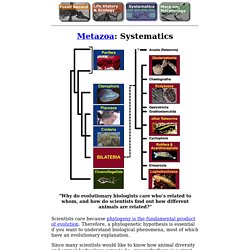
Therefore, a phylogenetic hypothesis is essential if you want to understand biological phenomena, most of which have an evolutionary explanation. Since many scientists would like to know how animal diversity and animal body plans came to be, presently there is a great deal of work on resolving the evolutionary relationships among the major groups of animals. Much of this research has relied upon morphological characters, especially those expressed in early development (e.g. embryological characters).
More recently, a significant advance in our understanding of animal phylogeny has been brought about by the study of molecules (in particular genes and their protein products) contained within animal cells. Elasmobranchs. What is an Elasmobranch?
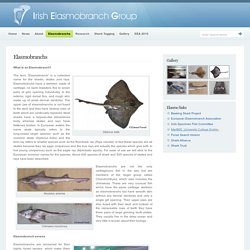
Dipturus batis The term “Elasmobranch” is a collective name for the sharks, skates and rays. Elasmobranchs have a skeleton made of cartilage, no swim bladders, five to seven pairs of gills opening individually to the exterior, rigid dorsal fins, and rough skin made up of small dermal denticles. The upper jaw of elasmobranchs is not fused to the skull and they have several rows of teeth which are continually replaced. Most sharks have a torpedo-like streamlined body whereas skates and rays have flattened bodies. Mustelus asterias Chimaera monstrosa Elasmobranchs are not the only cartilaginous fish in the sea but are members of the larger group called Chondrichthyes, which also includes the chimaeras. Elasmobranch senses Ampullae of Lorenzini Elasmobranchs are renowned for their highly tuned senses, which make them incredibly successful in their environment.
Reproduction White skate egg case Starry smooth-hound pup Starry smooth-hound embryos Special adaptations. Untitled Document. Species of the Late Devonian genus Eusthenopteron are known from all northern continents (Long, 1995).
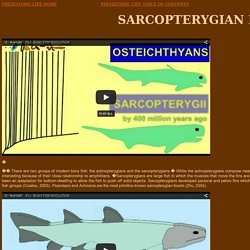
There are a number of rhipidistians which show great similarities to the early amphibians. Although Eusthenopteron is perhaps the best known, there are some that were even closer to amphibian lineage. The skull of Osteolepis shows closer affinities to the amphibians than that of Eusthenopteron but unfortunately fossils do not include the fins and girdles. An Error Occurred Setting Your User Cookie. KML Blog. July 16, 2010 This summer KML has been glad to again be a part of Dr.
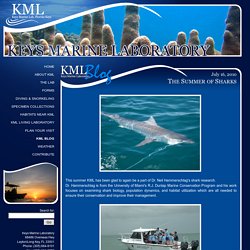
Neil Hammerschlag's shark research. Dr. Hammerschlag is from the University of Miami's R.J. Dunlap Marine Conservation Program and his work focuses on examining shark biology, population dynamics, and habitat utilization which are all needed to ensure their conservation and improve their management. The group has gone out 10 times with KML on the R/V Diodon to locations off the reef near Long Key, in Hawk Channel, bayside near Conch Key, and in the Everglades. Last month a news crew from CNN accompanied Hammerschlag's group along with a troop of high school volunteers that are always eager to learn more about the ocean's top predators. The KML staff is looking forward to assisting the group with their upcoming research trips next month.
Andrew G Crowder July 12, 2010 The tiger flatworm, Maritigrella crozieri on the ascidian Ecteinascidia turbinata. Andrew examining Ecteinascidia turbinata on the mangrove roots. Cindy Lewis.